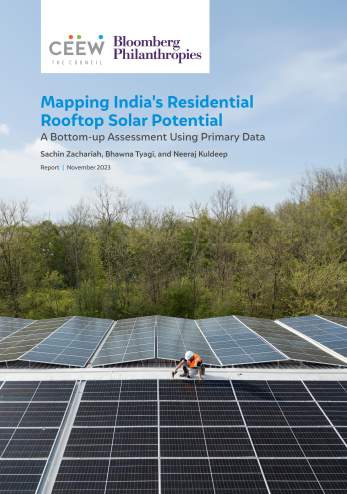Policy Brief
Solar Pumps for Sustainable Irrigation
A Budget Neutral Opportunity
Shalu Agrawal, Abhishek Jain
August 2015 | Energy Transitions
Suggested citation: Agrawal, Shalu, and Abhishek Jain. 2015. Solar Pumps for Sustainable Irrigation: A Budget Neutral Opportunity. New Delhi: Council on Energy, Environment and Water.
Overview
This issue brief recommends a budget-neutral approach for incentivising the adoption of solar pumps for irrigation in India. It estimates the resources available to states for incentivising solar pumps instead of awarding new agricultural connections. It also examines the parity between solar and electric pumps from an economic perspective. Further, the study discusses factors determining farmers’ preferences for solar or electric pumps.
As of March 2015, India had around 19 million agriculture connections for irrigation through electric pumps, which reportedly consumed 166 billion units of power (~22% of total sales) in 2013-14. However, power for agriculture connections is heavily subsidised, leading to poor returns for utilities and wasteful consumption. The existing connections face the challenge of unreliable and limited supply. Moreover, lakhs of farmers are waiting to get their agricultural electricity connection. A sizable number of farmers rely on diesel pumps because of the unavailability of electricity or connection.

Key Findings
- State governments incur INR 2,27,000 on every new agriculture connection over a 15-year period. The expenses to facilitate irrigation through electric pumps can be alternatively used to subsidise solar pumps.
- In order to increase the penetration of solar pumps from the current 0.1 per cent to 1 per cent, 0.3 million units need to be deployed, requiring subsidies of the order of INR 7,500 crore.
- A budget-neutral approach can enable state governments to subsidise the capital cost of solar pumps by up to 63 per cent, 45 per cent and 23 per cent in states with high, moderate and low levels of agriculture power subsidy respectively.
- Under the current scenario of high subsidies on power for agriculture, farmers might still find electric pumps more economical than using solar pumps.
- However, the high waiting time for new connections, poor quality of agricultural power supply and the costs associated with both could tilt the balance in favour of solar pumps.
- Erratic and poor quality agriculture power supply across most states has resulted in frequent damages to the pumps and increased the cost of repair and maintenance for farmers.
Key Recommendations
- Incentivise solar pumps in lieu of awarding new agriculture connections through electric pumps.
- Estimate the expenses likely to be incurred on an agriculture connection. Undertake the exercise keeping in mind the likely trajectory of agriculture tariffs over the expected life of solar pumps using the methodology employed in this study.
- Assess the suitability of solar pumps in providing sustainable irrigation, before scaling it up.
A budget-neutral approach would enable governments to subsidise capital cost of solar pumps by up to 63 per cent, 45 per cent and 23 per cent in states with high, moderate and low levels of agriculture power subsidy, respectively.







